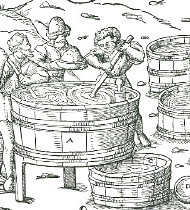Shooting the Handgonne
and how it probably was done the medieval way
This movie is designed for Windows Media Player. Users of FireFox or Mac need a Media Player plug-in
| Alemannisch (original) |
|||||
| English synchronized |
|||||
Aurel Schaffner, an experienced gonne shooter, introduces you to the equipment of a 15th century handgonner and demonstrates, how the handgonne highly probably was loaded and fired. In this movie a copy of the so called "Tabor Handgonne" is used. The original of this gonne once played a role in the Husit wars in eastern Europe 1419-34.
Accessories of a handgonne?
From pictures and artifacts which came down to us, we are well informed how a musket was fired in 17th century. But we know little about the way a handgonne was shot in late 14th and early 15th century. Though there are many pictures showing handgonne wariers in action, no picture shows their equipment. How did they carry their powder, matches, bullets, wads and ramrods?
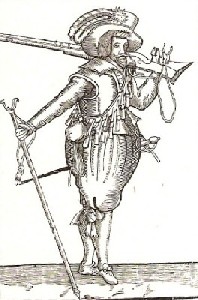 |
Fig. 1: A musketeer at left, ca. 1650. Clearly visible is his equippment. Slow match, cartridges and a bullet pouch, hanging at a bandelier, wound around his shoulder. |
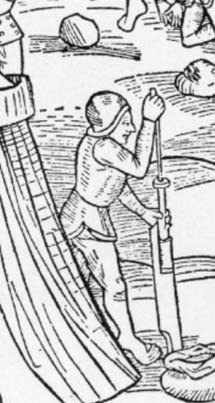 |
||||||
| Fig 2: Handgonner loading his gonne. Not a hint of accesories used for loading, safe a ramrod he's using. (ca.1450) |
||||||||
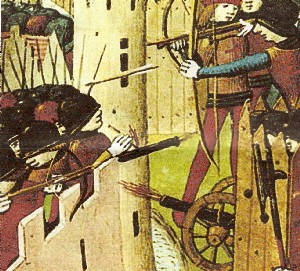 |
||||||||
| Fig 3: Scene from the battle of Grandson in 1476 (Switzerland), painted by Diebold Schilling (1445-86) Clearly visible is the hand gonner who is about to ignite his gonne by a piece of hand held match cord. So this one didn't use a match holder. But this leaves the queston: Where did he stow his burning match amidst this crowd while loading? |
||||||||
Images of handgonners have one fact in common with wild-west movies: The heroes are shooting endlessly without ever being forced to reload! Did they already carry a bandolier around their shoulder with wooden cartridges and a pouch filled with bullets? How did they carry the powder horn and the priming powder flask? At least we can take it from Fig. 3, they ignited the gonne by a hand-held slow-match. The painter, Diebold Schilling, was a contemporary, so he might certainly have known it.
Tactical employment of handgonners
Handgonners weren't tactically organized like archers and later the musketeers, who fought in organized units and fired their weapons synchronized on command. Far from this handgonners mostly were acting as individuals. I haven't ever seen a picture showing them as part of a military body on a battle field. Mostly you see them as defenders of a fortification or as individuals in a siege , such as in fig. 2.Equipment of a handgonner
About the equipment of a handgonner I don't know anything, I have to admit this. That's because there is no picture handed down to us, showing such a shot with his equipment.
But from the experience of a modern handgonner I certainly can make a good guess. As a minimum accounterment you need at least a powder horn, some lead bullets, some kind of a wad or patch for keeping the bullet safely seated in the barrel and some kind of a ramrod. And further a readily available slow match.
But how did a handgonner carry all this equipment with him? My good guess is a bag, slung over the shoulder like a hunter his possibles bag. You see this demonstrated with this movie where it works fairly well.
Performance
So far historians mocked the effect of handgonnes. Mostly these ignorants credited handgonnes with frightening the enemy by unexpected smoke and bang at best. They accuse ineffective, primitive black powder for this.
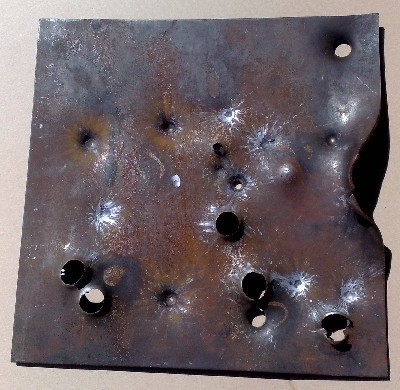 |
|||
| Fig. 3: This photo shows impacts from the Tabor handgonne, cal 18mm, as used in the movie above, on a 3 millimeter steel plate (St37). The smaller dents are caused by 9 mm bullets from a 9 mm Swiss army pistole which didn't pierce this steel plate. |
|||
With these tests I certainly will contradict former historians. Even with primitive, homemade black powder they were capable of piercing any personal armor used in the middle-ages.
